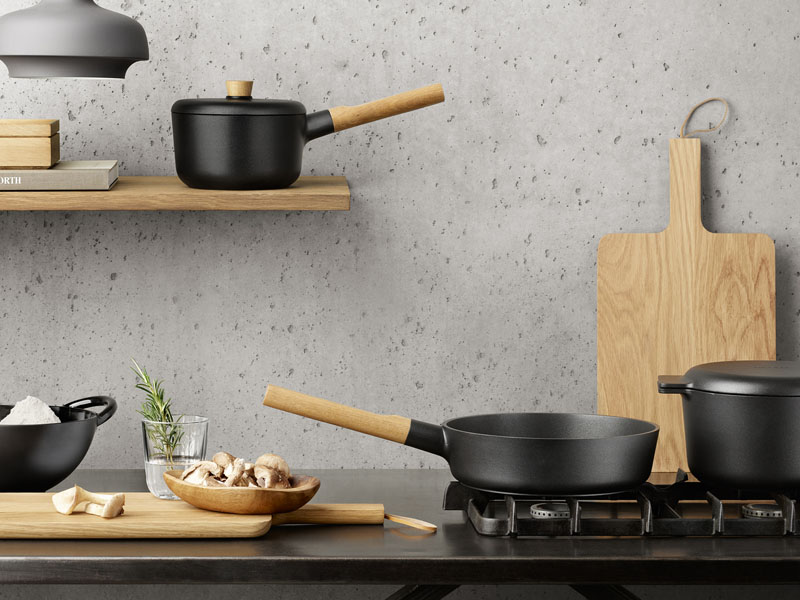Essential Kitchen Cookware
So you’ve promised to cook for that special someone in your life… only to look around and see that your kitchen arsenal consists of half-melted tupperware and the pots and pans your old college roommates have left behind. If it’s time to rebuild your kitchen & dining cookware from the ground up, read on and arm yourself with information. After all, five-star cooking starts with the correct tools.
Types of Pans
Sauce Pans
Your saucepan’s utility goes beyond your standard béchamels. With a lid clapped down on top, it’s also useful when it comes to boiling and steaming vegetables. A non-stick surface is essential when it comes to preparing rouxs and cooking without frying. Sauce pans can be quite shallow, so they’re ideal for quick dinner preparations. A good sauce pan or two in the cabinet means you’ve always got a few culinary options.
Pans over three quarts are great for starches like rice and polenta, but a two quart pan is all you need for quick sauces or reheating liquids.
Frying Pans
A simple pan with a ton of available uses, frying pans are built to do everything easily. The flat surface and low sides make it easy to flip pancakes or omelettes. And, as you may have guessed, it’s a great friend on fry day. Whether you’re making your own deep-fried sides or pan-frying a trout with just a little bit of compound butter, the limits of your pan are only defined by its size and depth… as well as your imagination.
A 10 or 12” frying pan is standard: try using the 12” size to make the biggest pancakes around.
Sauté Pans
High sides mark the greatest difference between a sauté pan and your average sauce pan. These walls offer more of a cooking area when it comes to braising or frying — they’re best for cooking anything in oil, butter, or delicious fat. In fact, “sauté” is French for “jump” or “bounce,” and refers to what these pans do best — help you toss, flip, and tumble your ingredients into the ultimate meal. Sautéeing is also one of the faster ways to cook something on a stovetop, so these pans are crucial in any kitchen.
Start your collection with a 12” sauté pan — serious chefs or those in large families can also keep an eye out for larger pans — 6 quart pans will help you feed a small army.
Cast Iron Skillets
A skillet, by definition, is a pan with sides that slant inward toward the pan's base. Most skillets and frying pans are sold as one and the same, but when it comes to cast iron skillets, there’s no comparison. For the best sear that you can get on a stovetop, cast iron skillets are the tried and true favorite. Cast iron distributes heat perfectly evenly, and can be slid into the oven when it comes time to bake or finish cooking thick cuts of meat, and it develops a natural seasoning with use that only gets better with age.
Cast iron skillets come in all sizes, but you can’t go wrong with a 12” size. They’re obviously much heavier than aluminum or stainless steel, so the larger sizes can be unweildly.
Types of Pots
Stock Pots
You’ll find a thousand ways to use your stock pot — although their most obvious application is in making stock. A good stock can be the base of almost anything, from the base of a sauce, stew, braise, or even as a cooking medium for poaching or making grains. Any time you want to start with an original flavor, this is the pot to reach for. In fact, you’d be surprised at how far this pan can take the flavor of some leftover veggies and chicken bones.
Poach a whole chicken in a 10 quart stock pot, or stick to everyday cooking with one between 4-6 quarts.
Soup Pot
Soup pots are good go-tos for everything from boiling water for eggs or pasta, to creating the dreamy winter soup of your dreams. Similar to a stock pot, a soup pot is built with high sides to contain boiling liquids, but its bottom tends to be much heavier. This allows soups and stews to heat evenly — even the thicker chowders or pea soups you love.
It’s fine to stick with an 8 quart pot if you’re a beginner, but the bigger the soup pot, the more you’re sure to find yourself using it.
Dutch Ovens
Another piece of cookery that’s traditionally offered in cast iron, dutch ovens are thick-walled cooking pots with lids to help seal in liquids as you cook. First created in the 17th century and made famous by La Creuset, their cast iron interior means that heating stays steady, even if you pop everything into the oven. Slow cook roasts, rumps, and other meat dishes are only the ground floor of options — you can cook everything from sides to sauces to homemade bread in these babies.
A 6 quart oven is sufficient to start with, but if you’re habitually preparing meals larger than a whole chicken, it’s time to graduate to a larger size.


